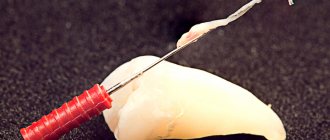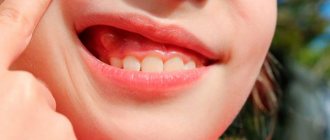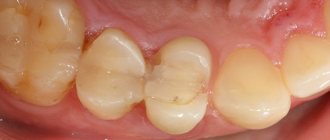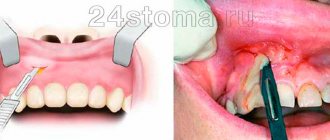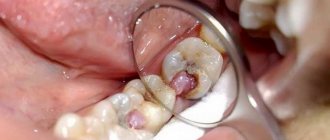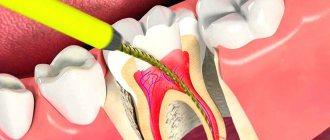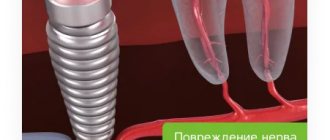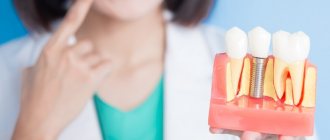Toothache during a cold: causes and treatment
One of the symptoms of a common cold, along with high fever, runny nose and cough, can be toothache. Teeth that are completely healthy at first glance can turn out to be a source of pain and signal problems with the body. When a toothache occurs due to a cold, adequate treatment prescribed by a general practitioner can quickly relieve you of this unpleasant symptom.
Why does toothache occur with a cold?
Toothache, along with headache and earache, can be a symptom of a cold. It occurs most often due to such a phenomenon as the occurrence of excess pressure in the nasal sinuses. When you have a cold, your sinuses become inflamed, and the mucus that forms in them blocks the passage, creating pressure that leads to pain. As soon as the inflammation of the mucous membrane is relieved, the teeth stop hurting. In addition, when we have a cold, we often drink a lot of liquids that contain acid. It can have a harmful effect on tooth enamel and cause pain. Also, when we have a runny nose, the mucous membrane of our mouth dries out quite noticeably, and the sugar that lingers on it in this way can also negatively affect the teeth.
Toothache due to a cold: treatment
So, we have looked at the main reasons why toothache most often occurs during a cold. Treatment prescribed by a therapist will help you recover as quickly as possible, and therefore get rid of painful sensations in your mouth. In the meantime, while the healing process is underway, you can relieve toothache using one of the proven home remedies.
- Rinsing with a baking soda solution (1 small spoon per glass of warm water) will help relieve inflammation and reduce irritation in the mouth. To achieve maximum effect, it is best to rinse your mouth 2-3 times an hour until signs of improvement appear.
- Dental drops. They can be purchased at any pharmacy for a small price. These drops have a calming effect and are based on camphor and valerian. It is enough to apply a few drops on a cotton swab and apply to the aching area.
- Sage decoction. Keep the warm sage decoction in your mouth for a few minutes, and you will notice that your toothache will become much less intense.
- Painkillers. If toothache causes you a lot of problems during a cold, then you can use any of the painkillers: ibuprofen, paracetamol, etc. The main thing is that the benefits of their use outweigh the harm they can cause to your liver and the entire body as a whole.
You can get a consultation at the DENTISTRY clinic. Make an appointment by calling +7 (8342) 308–088 or using the form below.
Make an appointment
Is it possible to visit the dentist with a high temperature?
If a cold is accompanied by an increase in temperature, then all qualified dentists will say that it is impossible to treat teeth during this period. The appearance of a high temperature is a sign that the body is fighting the viruses that have infected it. During a cold, the body uses all its strength and capabilities, and additional intervention can only do harm. In addition, in this state, the healing process of any wounds that may arise during dental procedures can be greatly delayed, and, consequently, the possibility of getting new infections will increase. But the situation is completely different if the temperature is caused not by a cold, but by an inflammatory process in the oral cavity. Under such circumstances, seeking the help of a dentist is not only possible, but also necessary, and as soon as possible. After all, even a small cyst in the soft tissues of the oral cavity can lead to serious consequences.
Features of dental treatment during a cold
If you need to go to the dentist during a cold, you should consider the following:
- ARVI is a disease commonly called a cold that is of viral origin. The presence of any pathogenic microorganisms in the body significantly weakens the immune system. Consequently, any dental treatment may be complicated and the recovery period may take longer.
- Any disease, including a cold, is stressful for the body. Therefore, the response to dental treatment can be unpredictable. For example, the effect of the anesthetic may be weaker, and the pain after tooth extraction or depulpation may spread to the entire face.
- Due to general intoxication of the body, the immune system becomes hypersensitive. She may react to the anesthesia with allergies.
Preventive actions
To reduce the risk of dental diseases, you should follow these rules:
- Brush your teeth twice a day.
- Visit the dentist twice a year.
- Preventative professional cleaning of units once a year.
- Avoiding foods that are too hot or cold.
- Carry out enamel whitening only in trusted dental centers.
- Treat your teeth in a timely manner.
- Be more attentive to your health and avoid complications such as otitis media.
- Get rid of bad habits.
- Choose a paste without abrasive particles.
- Additionally, use an antibacterial mouthwash, dental floss and irrigator.
Indications for tooth extraction
Extirpation is done when therapeutic treatment is impossible or before prosthetics. It can be planned or emergency. It is carried out using a simple or complex method. In the first case, the dental unit is removed from the socket using forceps, and in the second, dissection of the gums, alveolar bone, and sawing of the roots into fragments may be required.
Indications for emergency surgery:
- the presence of purulent inflammation, fistula, cyst;
- acute pain that is not relieved by medication;
- fracture of the crown, root.
Planned extraction is done if:
- advanced caries, if the area of the carious cavity of the crown is more than 70 percent, the pathology has spread to the root part;
- pulpitis in a complex root system, when it is impossible to properly clean the canals (usually in a figure eight);
- periodontitis with stage 3 or 4 mobility;
- third molars that interfere with neighboring ones cause changes in bite, facial asymmetry, neurological pain, pericoronitis;
- supernumerary, dystopic, impacted teeth, which cause various disorders in the dental system;
- orthodontic indications for prosthetics, installation of braces.
Experienced dentists always strive to preserve the integrity of the dentition, so radical measures are usually taken in the absence of a positive result of therapeutic treatment. After the procedure and recovery period, acute pain goes away, but chewing function worsens when removing molars or aesthetics when extracting incisors or canines.
When is it not recommended to treat teeth for a cold?
If a person has an appointment at the clinic, but fell ill the day before, he should cancel the visit to the doctor in the following cases:
- Treatment of unadvanced caries was planned. If the unit does not hurt, it is quite possible to shift the therapy to 7-10 days. Usually this period is enough to completely recover from ARVI. During the days of treatment for ARVI, maximum attention should be paid to carious cavity care. It is important to clean it of food debris after every meal. In order to slow down the process of destruction of dental tissues, you need to treat them twice a day with a special remineralizing gel. You can buy it at the pharmacy.
- A high temperature is caused by a cold. Fever is a contraindication to any dental intervention.
- A planned removal is required. The period of illness is not at all suitable for such operations. First, the body may react poorly to the anesthetic drug. Then a severe allergy will develop. Secondly, the immune system spends all its energy trying to defeat the virus. This means that the healing processes in the socket area will proceed more slowly, and the risk of wound infection will increase.
- On the eve of visiting the dentist, the patient took acetylsalicylic acid. A week before dental procedures, you should stop using this drug. This is due to the fact that Aspirin strongly thins the blood. This increases the risk of bleeding even with minor medical manipulations.
- The nose became very stuffy, and nasal breathing became impossible. While the doctor is treating the affected molar, canine or incisor, the patient has to breathe through his nose. He simply cannot take a full breath through his mouth. But, if you don’t want to put off visiting the doctor, you can cheat a little - use an effective vasoconstrictor spray ten to fifteen minutes before entering the dentist’s office. True, the drug for rhinitis will still have to be agreed upon with the dentist. After all, it is possible that it will be incompatible with the medications that the dentist will use during treatment.
It is important to understand that the final decision on the advisability of therapy during a cold should be made by the doctor. If a person doubts that a visit to the clinic can be postponed, he should call the dental center and consult with a specialist by phone. This is a fairly common practice.
When treatment is necessary
Among the situations when treatment of an oral disease is urgently needed:
- The ailments appeared a few days after the toothache began or simultaneously with it. This may indicate that a condition mistaken for a cold is, in fact, a sign of the progression of dental pathology. For example, weakness, migraine and high body temperature often indicate the progression of pulpitis, inflammation of a dental root cyst, and damage to soft tissues.
- The pain in the unit is so severe that it cannot be reduced with modern analgesics. Then the person takes one tablet, followed by a second. Then he changes the painkiller to a stronger one, but all attempts made are in vain. Most often, severe discomfort occurs during purulent processes. These are always difficult and dangerous conditions. If they are not diagnosed and treated in time, pus can spread through the bloodstream throughout the body. The consequences of this will be sad - even death.
- Pus is released from the diseased unit, body temperature is constantly elevated and practically does not decrease after using an antipyretic. This symptom complex indicates a serious inflammatory process. It needs to be stopped as soon as possible.
- A jaw injury was sustained. In the first hours after damage to the dental crown, certain measures can be taken to restore it. If you wait, then it will not be possible to restore the integrity of the surface of the unit in a natural way - you will have to carry out prosthetics in the future.
In these situations, the dentist will definitely provide treatment, regardless of the patient’s cold symptoms.
Features of the disease
There is a widespread misconception about the safety of colds for an adult; most people disdain the need for bed rest and limiting exercise until complete recovery. When the first signs of ARVI appear: sore throat, nasal congestion, treatment should begin, ideally under the supervision of a qualified specialist. Complications after a cold are common: kidney and heart diseases. After the first signs, a cough, runny nose begins, the temperature rises, and the disease develops rapidly. Many suffer from a cold “on their feet”, doing their usual things, visiting public places, limiting themselves to taking modern medications that do not cure, but relieve symptoms.
ARVI is a threat to others; viruses live indoors for more than 7 hours. A visit to the dental office by a sick person is accompanied by the risk of infection of staff and visitors. Dental treatment during ARVI is a risk for the patient himself; the weakened body does not resist and is not protected from other infections and viruses.
How to help yourself at home
A cold does not mean that you have to wait for recovery and endure toothache. To get rid of unpleasant sensations and minimize the likelihood of complications, you should:
- Do not ignore the requirements for careful hygiene of teeth and gums. Even if you feel unwell, you need to brush your teeth twice a day, and after each meal or sweet drink, rinse your mouth with clean water.
- Take symptomatic medications that are used for ARVI, as they contain painkillers that will help eliminate pain.
Try not to chew hard food on the side of the diseased tooth until you go to the dentist; it is better to switch to soft food for a while.
Anesthesia for tooth extraction
There are several types of pain relief:
- local anesthetics that are injected into the gums;
- drugs for general anesthesia injected into a vein;
- inhalation anesthesia;
- nitrous oxide sedation.
The choice of method depends on what kind of operation is being performed: simple or complex. Removing the front teeth is considered the easiest. They have one root and are easily dislocated with forceps. For pain relief, a simple “freezing” with a local anesthetic is sufficient.
Removing lower wisdom teeth is the most difficult procedure, especially if there are abnormalities in growth and location. It will require cutting the gums, cutting off part of the bone, sawing and step-by-step removal of root fragments. The operation can last more than 1 hour, so it is often performed under anesthesia.
Sedation with nitrous oxide does not exclude local anesthesia. It relaxes well, puts the patient into a state of half-asleep, and reduces fear. Often used in pediatric dentistry to remove baby teeth.
Drugs injected into a vein completely turn off consciousness for a certain period of time. The duration of anesthesia is adjusted by the dosage of the medication.
Inhalation anesthesia allows you to control the dose of the drug directly during the procedure. This ensures high-quality and safe general anesthesia and minimizes the risk of side effects.


